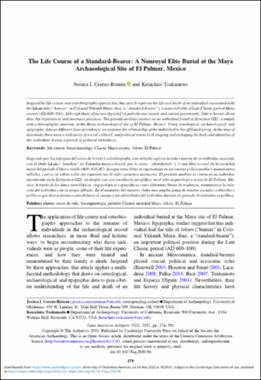| dc.description.abstract | Inspired by life course and osteobiography approaches, this article explores the life and death of an individual associated with the lakam title (“banner” in Colonial Yukatek Maya; thus, a “standard-bearer”), a nonroyal elite of Late Classic period Maya society (AD 600–850). Although these elites are depicted on polychrome vessels and carved monuments, little is known about their life experiences and mortuary practices. The present analysis centers on an individual found at Structure GZ1, a temple with a hieroglyphic stairway, at the Maya archaeological site of El Palmar, Mexico. Using osteological, archaeological, and epigraphic data as different lines of evidence, we examine the relationship of the individual to his affiliated group. At the time of interment, there were a wide array of social, cultural, and political events both shaping and reshaping the body and identities of the individual during a period of political turbulence.
Inspirado por los enfoques del curso de la vida y osteobiografía, este artículo explora la vida y muerte de un individuo asociado con el título lakam (“bandera” en Yukateka maya colonial, por lo tanto, “abanderado”), o una élite no-real de la sociedad maya del período Clásico tardío (600–850 dC). Aunque estas élites se representan en las vasijas policromadas y monumentos tallados, casi no se saben sobre sus experiencias de vida y práctica mortuoria. El presente análisis se centra en un individuo encontrado en la Estructura GZ1, un templo con una escalinata jeroglífica, en el sitio arqueológico maya de El Palmar, México. A través de los datos osteológicos, arqueológicos y epigráficos como diferentes líneas de evidencia, examinamos la relación del individuo con su grupo afiliado. En el momento del entierro, hubo una amplia gama de eventos sociales, culturales y políticos que dieron forma y remodelaron el cuerpo y las identidades del individuo durante un período de turbulencia política. | en_US |

